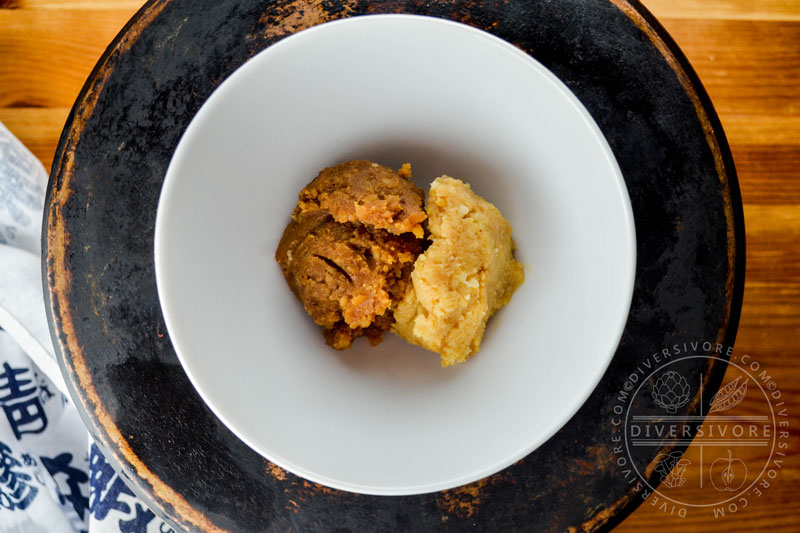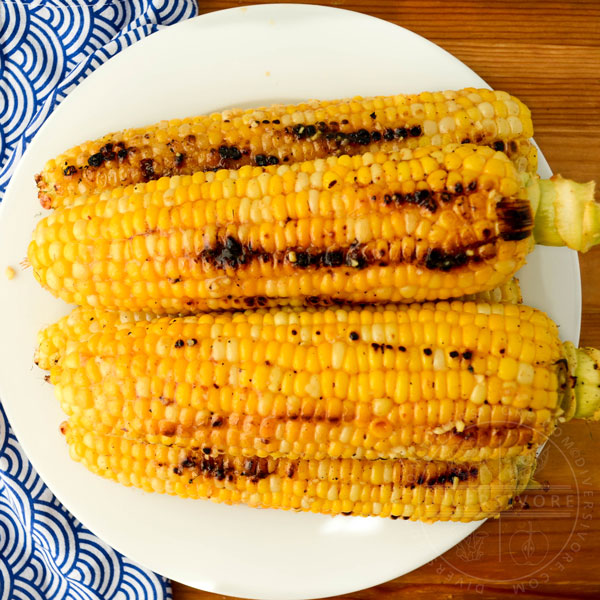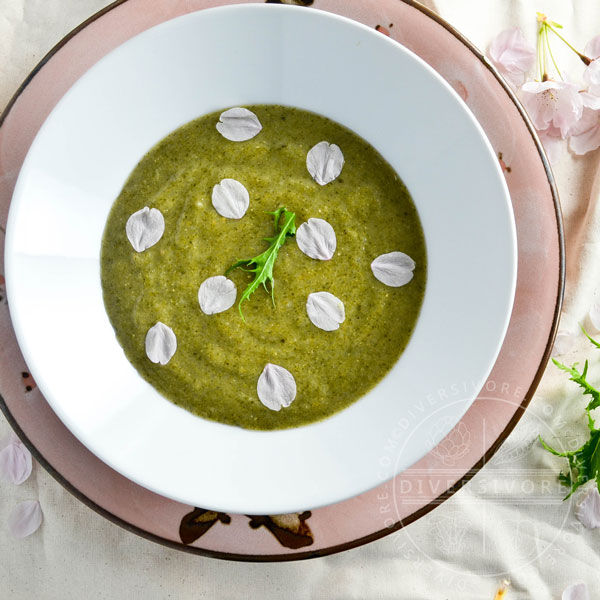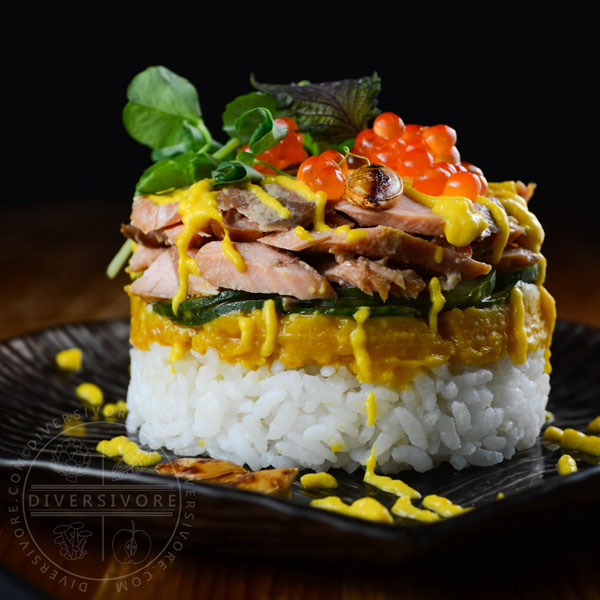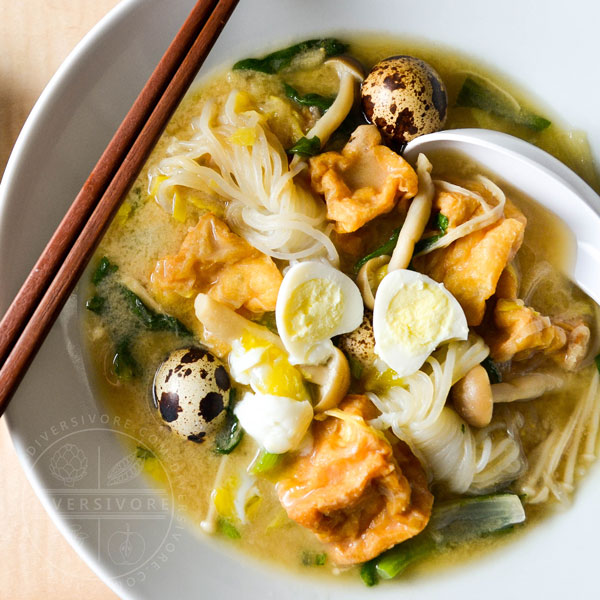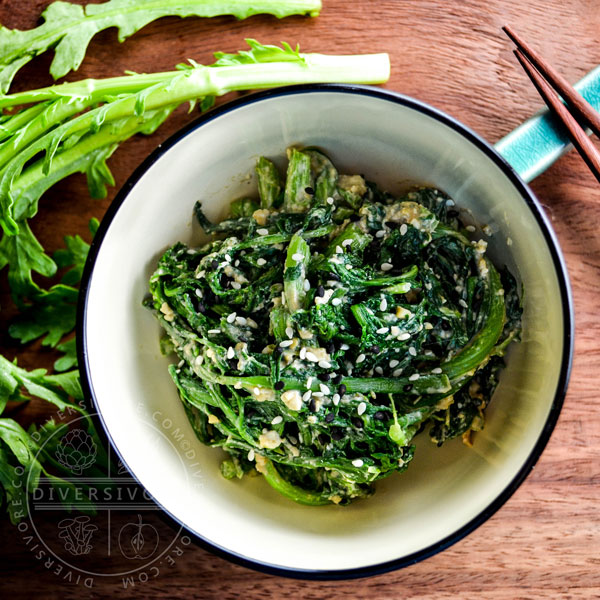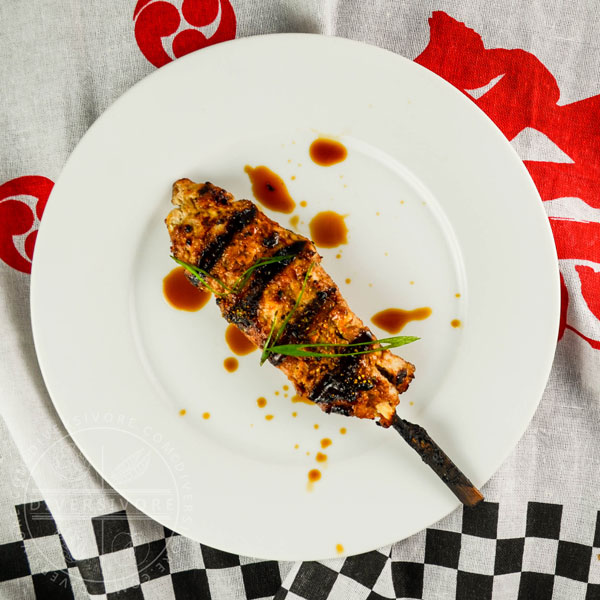RICE MISO, (米味噌) also called kome-miso (KO-may), is the most common type, both in usage and availability. It is made with soybeans, rice, rice koji (bacterial culture), and salt. Common ingredients aside, this is really a category of miso, and not really a specific type in and of itself. Instead, the rice miso pastes are further broken down into the following categories:
AKA MISO (赤味噌) or
Red Miso - A relatively strong but very versatile miso, fermented naturally for 1-3 years or using controlled temperatures for 3-4 months. Possibly the most versatile of all rice-based miso varieties, it is well-suited to a broad array of dishes. It also tends to be one of the saltier miso varieties, and one of the lowest in carbohydrates. Famous Japanese varieties include Sendai, Echigo, Sado, and Tsugaru. Most modern varieties are relatively chunky. There are a few sub-varieties that may be encountered, including:
- Mellow Red Miso (Amakuchi Aka Miso) - A red miso prepared with normal salt levels and substantially reduced koji culture levels, this miso is lower in carbohydrates and a little sweeter than normal red miso. Normally fermented for 6-12 months, there are also Note also that there are Hawaiian mellow red misos, but these are not the same product (see below).
- Sweet Red Miso (Edo Miso, Edo Ama Miso) - A Tokyo specialty with lower salt and higher carbohydrate levels, this mellow, pleasingly sweet miso has long been popular for making simmered dishes, desserts and sweet treats. It begins to change in flavour fairly quickly after being made, making it difficult to export or obtain outside of Japan. A reasonable approximation can be made by mixing 3 parts red miso and 1 part honey.
SHIRO MISO (白味噌) or
White Miso, - A Kyoto specialty that has now become popular around the world, this sweet, mild miso is made with a large proportion of rice koji. White miso is quite sweet and very popular in desserts, light soups and stews, and alongside fresh or lightly cooked vegetables (it has become a popular salad dressing component). It is also popular as a pickling agent (i.e. for miso-zuke), but this is only true in regard to pasteurized versions. It has the highest proportion of carbohydrates and the lowest salt level of any miso and ranges in colour from a yellowish white to a medium yellow. Though it can slightly chunky, it is generally fairly smooth. Because white miso is quick to produce (its high levels of sugar cause it to undergo fermentation rapidly), it is not as shelf-stable as some other miso varieties. Unfortunately, this has led to the production of many heavily adultered versions, including bleaches, preservatives, and sweeteners. Many of these are also pasteurized. Fortunately, good quality, traditionally made white miso is becoming easier to find as interest in the product grows. This product should always be refrigerated - older white miso may redden slightly and develop a slightly alcoholic taste (though it will remain usable in this state).
SHINSHU MISO (信州味噌; often called
Yellow Miso, but also confusingly called White and Red Miso - see note below) - When made traditionally made, this miso from Nagano Japan resembles a lighter, less salty, tangy Sendai red miso. In its modern form, it is generally a quickly-produced smooth miso with a smooth, yellow to yellow-brown, with a light aroma and a mellow, slightly tart flavour. It tends to be a little lower in salt and protein than other miso varieties. Many modern quick-misos are made in this style, and some of these have colouring, flavouring, or preservative additives.
NOTE: Shinshu miso is a name that can only be applied to miso made using traditional ingredients and processes (at least in Japan), and so the quick-made varieties use other names. In English, the name yellow miso is very commonly used for this purpose, while a variety of Japanese names may be used (many of which are, confusingly, used for both traditional and quick miso pastes). That being said, thanks to the vagaries of translation, any number of English names may be used for quick misos, and the term yellow miso may still be used to refer to a traditionally made variety. When in doubt, try to consult the ingredients and, if possible, the fermentation method.
AWASE MISO (aka
Mixed Miso) - Technically any miso can be mixed together (resulting in
Chou Miso, which also means mixed miso), but this variety specifically refers to a mix of red and white miso varieties.
GENMAI MISO (玄米味噌) or
Brown Rice Miso - This miso is made with brown rice instead of white rice. Genmai miso is deliciously nutty and rich, and generally fermented for 6-18 months. It's well suited to the same sorts of dishes that would use red miso, though its flavour profile is quite different. It can be a little tricky to make, but good varieties from reputable companies are becoming easier to find. Interestingly, genmai miso has generally been more popular in North America than in Japan.
MELLOW HAWAIIAN MISO - Sometimes called Hawaiian-style miso, these mild, relatively sweet, less potent miso pastes were developed in Hawaii, and are still predominately found there. They tend to function as something of an 'all-purpose' miso, easily added to sweet and savoury dishes without overwhelming the flavours already present. White mellow miso is the most common, but red miso is made as well.
MUGI MISO (麦味噌), aka
Barley Miso, is a traditional miso variety that was historically more popular but has gone through something of a resurgence (especially in North America where it enjoys prominent 'health-food' status). It is generally made with barley, soybeans, koji culture, and salt. Some versions may include rice. It is bold, richly flavoured, and salty, with a heady, earthy aroma. The colour tends to vary from deep reddish-brown to a dark chocolate-brown depending on the length of the fermentation. Mugi miso is generally still made with traditional methods, including a long fermentation period (up to 3 years). There are two basic sub-varieties:
- BARLEY MISO (aka Karakuchi Mugi Miso) - the standard variety of barley miso, made with either polished or unpolished barley grains, this variety is what is what is most often being referenced in any recipe calling for barley miso. The flavour is rich and salty but surprisingly sweet.
- MELLOW BARLEY MISO (aka Amakuchi Mugi Miso) - as the name suggests, this variety is mellower and sweeter than standard barley miso, though it is not as sweet or mild as a mellow rice miso (e.g. sweet red or white miso). Unlike standard barley miso, this sweet variety is fermented and matured over a rather brief period of time.
MAME MISO (豆味噌) or Soybean Miso - This one might seem confusing, since all miso varieties are made of soybeans, but mame misos should be made entirely or primarily of soybeans, without added grains or with only small quantities. Some of the darkest and strongest varieties are referred to as
black miso (kuro miso), while the term
Sanshu miso is used to encompass many types. Mame miso tends to be quite strong and salty, and is often diluted somewhat in marinades or by combining it with other miso types. The best known variety is
hatcho miso. It and several other varieties are detailed below.
- HATCHO MISO (八丁味噌) - one of Japan's most distinctive and celebrated varieties, this dark brown miso is aromatic, savoury, mildly sweet, and somewhat astringent. This is said to be the miso favoured by the Emperor of Japan. It is aged for a long period (generally 16-24 months), though a younger (12-14 month) variety is also produced now with a milder flavour. Interestingly, Hatcho miso koji is made with a different and unique species of mold (Aspergillus hatcho). Because it has a very low water content, hatcho miso is extremely thick.
- ONE YEAR (REGULAR) SOYBEAN MISO (aka Ichinen Mame Miso) - This miso is produced in a fashion similar to hatcho, with two distinct differences. First, the aging time is reduced, and second, the standard Aspergillus oryzae mold is used to produce the koji. It has a flavour similar to hatcho miso, though it is milder, lighter in colour, and less rich. It is also softer, due to its higher water content.
- TAMARI MISO (aka Moromi Miso) - technically a byproduct of tamari making, this miso-like paste is becoming quite uncommon, as most tamari producers press the residue in order to get as much liquid out as possible. Long considered a very high-class food, tamari miso has a strong, slightly sweet flavour reminiscent of high quality brewed Chinese soy sauce. That being said, it has very little aroma.
MISO MADE WITH ALTERNATIVE GRAINS
There are many specialized miso varieties made with grains other than the standard ones already discussed, or with combinations of grains. The more common varieties include:
GOKOKU MISO (五穀味噌) - literally '5-grain' miso, this variety is made with wheat, barley, rice, proso millet, and foxtail millet (in addition to the requisite soybeans). The flavour is fairly strong and distinctive. Note that millet alone is now sometimes used to produce specialized miso varieties as well.
SOTETSU MISO (蘇鉄味噌) or
Nari Miso - Miso made from the seeds of a species of cycad (cycads are ancient, seed-bearing plants somewhat resembling a stout palm tree). Cycads are only found in the extreme south of Japan, and the making of this variety was historically a cottage industry on Amami Oshima, a southerly group of islands between Kyushu and Okinawa. Nari miso is undergoing a small cultural revival in the area, though it is still largely unavailable outside of Japan. Modern nari miso is made with wheat and soybeans along with the cycad (sotetsu or nari) seeds. Note that improperly prepared cycad can be toxic, so nari miso should only be obtained from a knowledgeable miso maker.
RYE (RAIMUGI) MISO - Miso made rye grains. This is a modern miso invention (rye was not historically common in Japan). Information on it is limited, but it seems to be made with wheat and rye in addition to the necessary soybeans.
SOBA MISO (蕎麦味噌) aka
Buckwheat Miso - A relatively uncommon but still traditionally prepared miso variety that incorporates buckwheat and wheat during the fermentation process. The taste is strong and distinctive, and will be familiar to any who have tried soba noodles or other buckwheat products.
TAIMA MISO aka
Hempseed Miso - Basically a standard rice miso that has had hemp seeds added during the fermentation period, this variety has a distinct hemp taste and aroma. While hemp has long been an important crop in Japan, this variety seems to be more common among niche miso makers in the West.
In addition to the varieties listed above, the following grains have been used to produce miso, both in and outside of Japan. Many of these are available from niche miso makers.
- Adzuki beans
- Amaranth
- Barnyard grass (Japanese millet)
- Black soybeans (which could technically be used to produce any number of miso varieties)
- Chickpeas
- Corn
- Quinoa
- Millet (without wheat or barley)
MIXED/PREPARED MISO
Lastly, there are the prepared miso varieties. This category encompasses a range of products that, while still miso, are actually combinations of a standard or specialized miso base and several other ingredients or flavourings. In some cases, the added ingredients are stirred into a finished miso, while in others they may be part of the fermentation process. Many of these prepared misos are quite popular, and they are used to prepare a wide variety of meals and snacks. Note that there are many Japanese dishes that have the word "miso" as a prefix (e.g. miso-zuke, miso-udon, miso-yaki, etc.). These are not types of miso (prepared or otherwise), but simply recipes that use miso as a primary flavouring.
NAME MISO (なめ味噌; pronounced nah-may mee-so) - One of the most popular prepared miso products, name miso is made by fermenting finely chopped salt-pickled vegetables in a specialized miso base. There are several sub-varieties of name miso made with different koji varieties and an array of vegetables and seeds. Name miso basically means "finger-licking" miso, an allusion to its popular flavour.
NANBAN MISO (南蛮味噌)- Literally "Southern Barbarian" Miso, this dish has had multiple meanings over the centuries, but now generally refers to miso mixed with hot chilies (and possibly other spices) and used as a dip or sauce.
